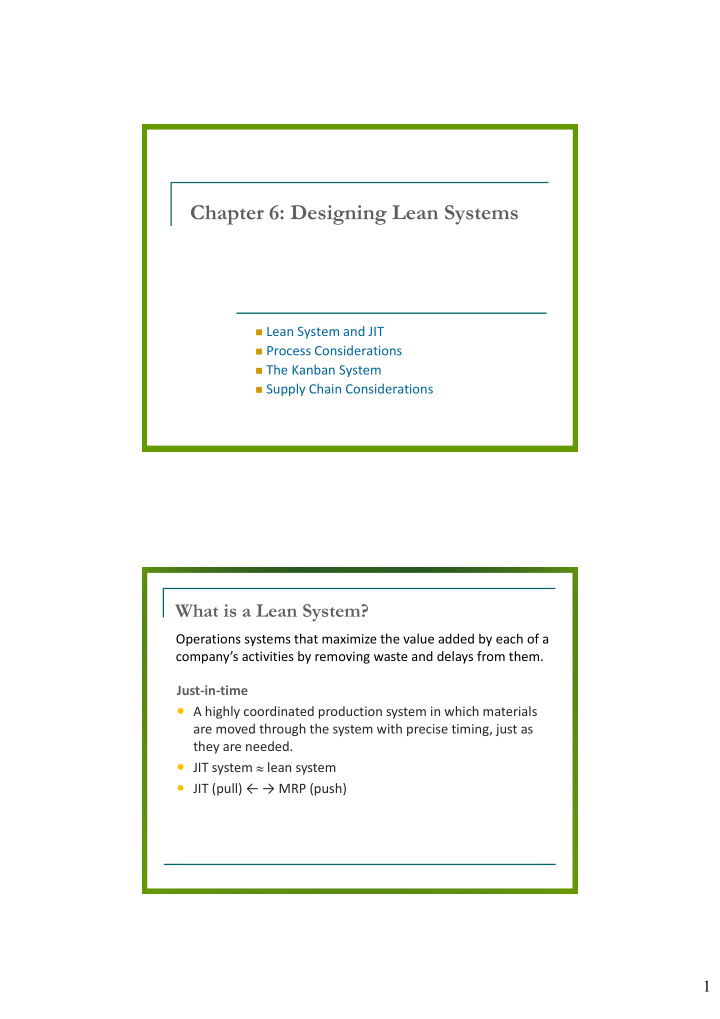



Chapter 6: Designing Lean Systems Lean System and JIT Process Considerations The Kanban System Supply Chain Considerations What is a Lean System? Operations systems that maximize the value added by each of a company’s activities by removing waste and delays from them. Just‐in‐time A highly coordinated production system in which materials are moved through the system with precise timing, just as they are needed. JIT system lean system JIT (pull) ← → MRP (push) 1
History of Toyota Toyota switched from automated looms to military trucks just prior to WWII. Secondhand equipment and high unit costs forced Toyota to reduce waste and improve quality whenever possible. 3 3 Eight Types of Waste (Muda) Overproduction 庫存過多、沒有改善品質的壓力 Inappropriate Processing 殺雞焉用牛刀 Waiting 人員或產品的等待過程不會創造價值 Transportation 物料搬運不會創造價值且易造成損壞 Motion 不必要的動作或行走不會創造價值且容易勞累 Inventory 庫存會隱藏問題、占空間、造成等待 Defects 增加檢查成本、時間與材料的浪費 Underutilization of Employees 浪費員工的時間與腦力 Waste can be eliminated by cutting unnecessary capacity or inventory and removing non‐value‐added activities in operations. 2
Process Considerations in Lean Systems Kaizen: continuous improvement (改善) Pull Method of Work Flow: supplying material based on demand using Kanban (看板) Quality at the Source: Jidoka: automatic detection (自働化) Poka‐yoke: fool‐proofing to reduce errors Uniform Work loads: Heijunka (平準化) Flexible Workforce: cross training, work rotation ( 兩小時換場制 ) 5S: 整理 SEIRI 、整頓 SEITON 、清掃 SEISO 、清潔 SEIKETSU 、素養 SHITSUKE Total Preventive Maintenance 全面預防保養 5 Kaizen: Continuous Improvement 水位高度相當於產能或庫存,暗礁代表生產線各種問題 降低庫存 生產線必須面對並解決各種問題 進一步降低庫存 6 3
Single Minute Exchange of Dies = Single Digit Setup faster set up smaller lot sizes smaller inventory internal setup external setup 事先調整定位、簡 易拆卸、預熱模具 F1 Pit Stops 1950 vs 2013_ Quick Changeover 7 Quality at the Source Jidoka Automatically stopping the process when something is wrong and then fixing the problems on the line itself as they occur. Poka‐Yoke Mistake‐proofing methods aimed at designing fail‐safe systems that minimize human error. 4
Heijunka leveling of production load 根據實際需求安排生產計劃,使生產量與生產內容平準化 當月計劃生產 800A 、 600B 、 400C 每週生產 200A 、 150B 、 100C 每天生產 40A 、 30B 、 20C 實際現場排程 AAAABBBCC AAAABBBCC mixed model assembly 9 Process Considerations in Lean Systems Flexible Workforce Workers can be trained to perform more than one job. A benefit is the ability to shift workers among workstations to help relieve bottlenecks. At some firms, workers may switch jobs every 2 hours. An environment to foster cooperation and mutual trust between workforce and management. Total Preventative Maintenance Maintenance is done on a schedule that balances the cost of the preventive maintenance program against the risks and costs of machine failure. Data can be collected for establishing trends in failure pattern of machines, which can subsequently be analyzed to establish better standards and procedures for preventive maintenance. 5
5S Separate needed items from unneeded items (including tools, parts, materials, and paperwork. Implement mechanisms to sustain the gains by involving Neatly arrange what is 整理 people and recognizing left. Organize the work them. area so that it is easy to find what is needed. 素養 整頓 Clean and wash the work area and make it shine. 清潔 清掃 Establish schedules and methods of performing the cleaning and sorting. House of Toyota Needs close cooperation between companies and their suppliers to improve efficiency and reduce inventories. 6
Kanban 由下游往上游拉 (pull) 的物料控制方式,看板提供的 相關資訊,包括時間、規格、數量、運送地點等 13 Operating Rules for Single-Kanban Systems 1. Each container in the process must have a Kanban card. (授權) 2. The assembly line (下游) always withdraws materials from the fabrication cell (上游 主動權) . The fabrication cell never pushes parts to the assembly line. 3. Containers of parts must never be removed from a storage area without a Kanban first being posted on the receiving post. (時機) 4. The containers must always contain the same number of good parts. 5. Only nondefective parts should be passed along to the assembly line (下游) to make the best use of materials and worker’s time. (品質) 6. Total production should not exceed the total amount authorized on the Kanbans in the system. (總量管制) 7
The Single Kanban System 1/4 Receiving post Kanban card for product 1 Kanban card for product 2 Storage area Assembly line 1 O 2 Fabrication cell O 3 O 1 Assembly line 2 Full containers O 2 The Single Kanban System 2/4 Receiving post Kanban card for product 1 Kanban card for product 2 Storage area Assembly line 1 O 2 Fabrication cell O 1 O 3 Assembly line 2 Full containers O 2 8
The Single Kanban System 3/4 Receiving post Kanban card for product 1 Kanban card for product 2 Storage area Assembly line 1 O 2 Fabrication cell O 3 O 1 Assembly line 2 Full containers O 2 The Single Kanban System 4/4 Receiving post Kanban card for product 1 Kanban card for product 2 Storage area Assembly line 1 O 2 Fabrication cell O 1 O 3 Assembly line 2 Full containers O 2 9
Determining the Number of Kanbans Supplies must be shipped frequently, have short lead times, arrive on schedule, and be of high quality. In US, such arrangements may prove difficult because of the geographic dispersion of suppliers. Too many kanbans excessive inventory Too few kanbans not enough supply to the next station. Two determinations: Number of units to be held by each container Number of kanbans (containers) between two stations Work‐in‐process L = W Little’s Law = demand rate W= average time a container spends in the process Example 6.2 A container of parts spends 0.02 day in processing and 0.08 day in materials handling and waiting Daily demand for the part is 2,000 units Safety stock equivalent of 10 percent of inventory If each container has 22 parts, how many kanbans are needed? 2,000(0.08 + 0.02)(1.10) 220 k = = = 10 containers 22 22 Suppose that a proposal would cut materials handling and waiting time per container to 0.06 day. How many kanbans are needed? 2,000(0.06 + 0.02)(1.10) 176 k = = = 8 containers 22 22 10

Recommend
More recommend